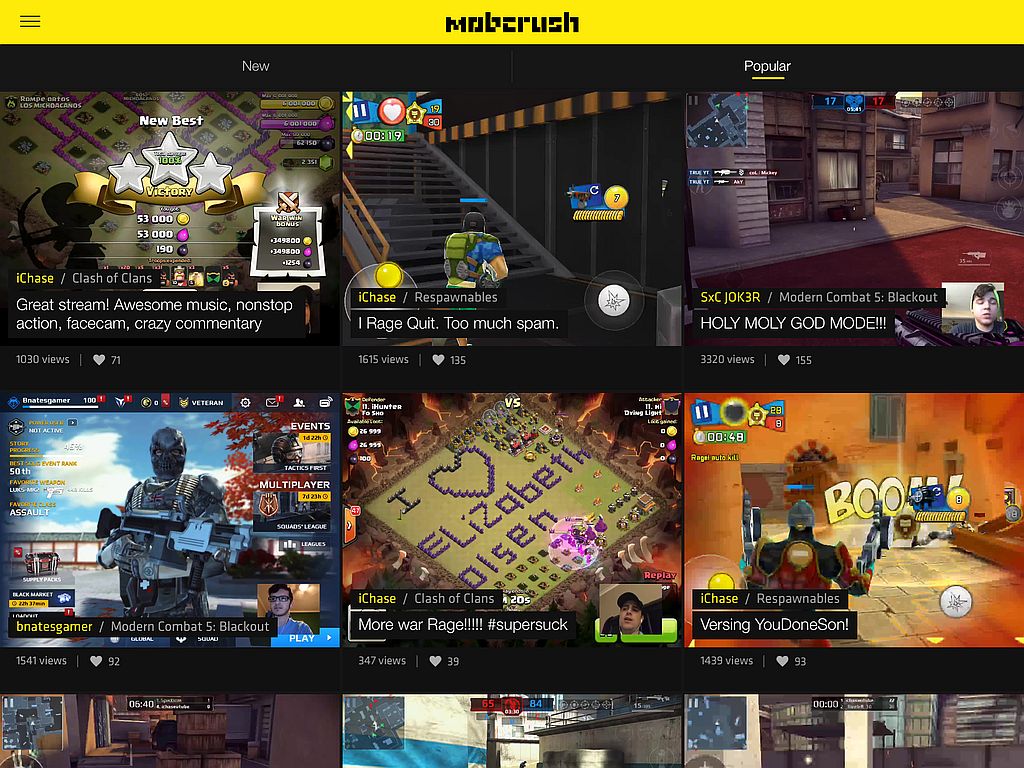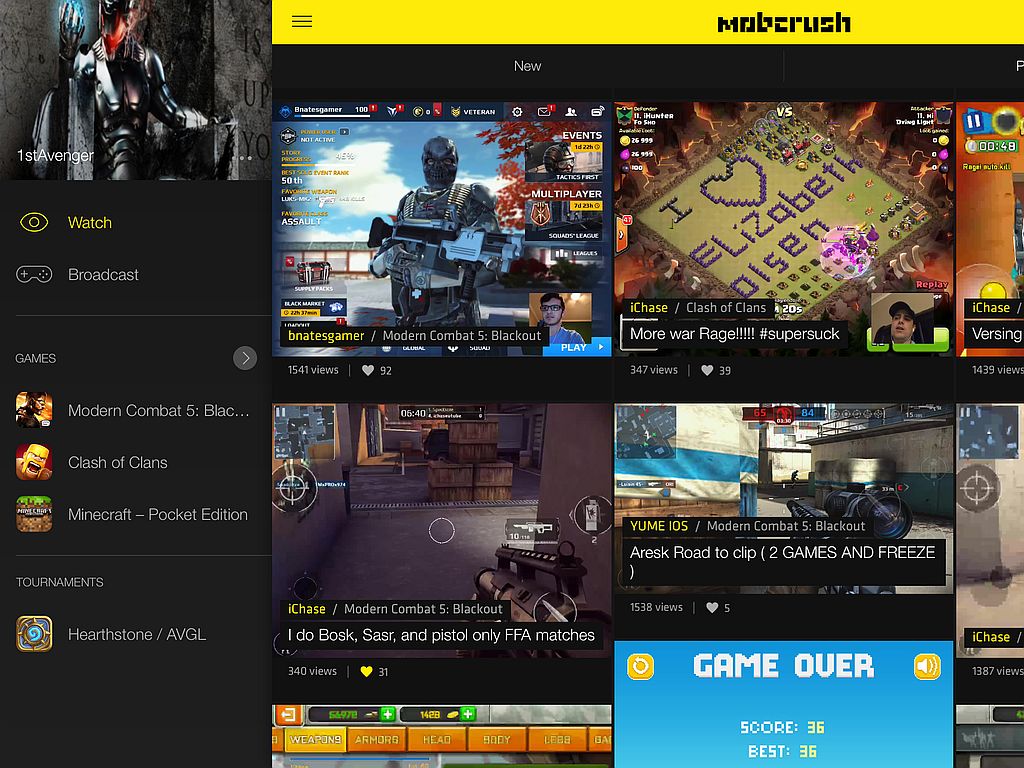Livestreaming games has proven tremendously popular, as the over 100 million views on Twitch every month will attest. Yet, for all this immense popularity, livestreaming has been mostly a PC-centric pastime, though the new generation of consoles, Xbox One and PlayStation 4, both make it easy to stream game play. Still, livestreaming revolution has largely passed by the fastest-growing game industry segment, mobile games. Until now, that is.
Mobcrush, the live streaming platform for mobile games, has raised $4.9 million in seed funding to support, entertain and connect the world’s one billion mobile gamers. Mobcrush is currently in private beta for iOS and Android and has gained early traction with mobile gaming guilds and players of popular games including Clash of Clans, Vainglory, Modern Combat and Minecraft. “Gamers have been able to livestream from desktop for some time now, and that has created tremendous demand for streaming of native mobile gameplay without the need for a PC and additional equipment,” said Matt Mazzeo, Managing Director of Lowercase Capital and an investor in Mobcrush. “Mobcrush packs the passion and the talent to lead streaming games into its next natural evolution, on mobile.”
“We are humbled by the player reception to Mobcrush, and to have investors show the same love has been a strong vote of confidence,” said Mobcrush CEO Royce Disini. Early investors in Mobcrush span industry leaders in games, technology and media. Mobcrush CEO Royce Disini spoke with [a]listdaily about the mobile game streaming market and its potential.
What are some of the difficulties you’ve had to overcome in live-streaming games on mobile?
Given our background, we’re the right team to pull this off. We’re a mobile-streaming DNA team that happen to be gamers as well. We bring a lot of expertise and experience to this platform. The first task we had is how do you grab content from the mobile device and stream it out. The other challenge is moving from WiFi to cellular, to device constraints, to network constraints. We were able to solve them in a very short amount of time, given our background. I think we’ve managed to overcome the challenges to be able to livestream a mobile game natively from a mobile device.
Do you see eSports coming to mobile gaming in the near future, now that mobile games can be live-streamed?
I think it’s a potential growth market. In fact, we actually have been testing it. About two months ago we ran a tournament among us and area college students. When they first found out about us they thought we were a direct Twitch competitor, but when we told them we’re a mobile platform they got excited. I asked if the community would be interested in running a mobile eSports tournament, and they got back to us really quickly and said ‘yes, the community here would love to try out Hearthstone on mobile.’ We made history two months ago — we didn’t do any press around, but it was the first Hearthstone tournament that was played and livestreamed from mobile devices. The community loves it so much over there, they’re asking us to come back and do a larger tournament.

What do game developers have to do to enable Mobcrush streaming with their mobile games?
One of our value propositions for game developers, if they want to get integrated, is it’s a zero line of code to integrate. Meaning it’s just a library include, it’s about a 1MB file footprint that a junior developer can integrate in ten minutes or less. We figured out a way to livestream mobile games even before partnering with a developer. We went straight to the community and let the community help us. We are actually able to livestream any mobile game from the device. Strategically we cautiously avoided playing the SDK game. After solving for the platform, and building a mobile-first platform, it becomes a community play. Twitch is a platform and a community for core PC desktop games. When we set about to do this, we think there’s white space in a mobile first, mobile game streaming platform and community. That’s one of the reasons why we decided to focus on mobile.
How will you monetize Mobcrush?
The most obvious model is video advertising with high CPM rates, given that it’s a video format. But we thought about it deeply — what’s unique about mobile One of the different things we’re developing for the monetization side is what we’re calling participatory microtransactions. What that is is this: Let’s say you’re watching somebody play Clash of Clans. Instead of waiting for that person to level up in twenty or thirty minutes, hey viewer, why don’t we contribute 10 cents to a dollar each to be able to buy this broadcaster gems (for Clash of Clans) or a special ax to go after Level 12 for another game We basically open up microtransactions not just from a gamer perspective at the game level, but also include specatators, which hasn’t been done before in this space. We will need access to their microtransaction API, but that’s why we’re going to have conversations with the developers we’re going to target.
What’s your marketing strategy for making people aware of Mobcrush and getting them to use it?
It’s been organic. We’ve been getting success in our private limited beta by not having a marketing person or spending a dime on marketing. When we first started out private beta, we approached a Clash of Clans guild leader, who brought in the rest of his clan. When they started using Mobcrush they started shouting it from the rooftops to invite other clan leads. We did the same to bring in Vainglory guild leads. More recently we’ve been inviting influencers over to the platform. There are some game influencers who happened across Mobcrush and approached us if they could test out the product. When one of our private users tweeted about Mobcrush a couple of weeks ago, we had unplanned growth of about 10x on our private beta. From my perspective, I think that’s the right approach: Have the community members and the rabid users of the product invite their friends and other influencers to stream on Mobcrush and bring the audience along with them.
When we grew 10x the first time, we actually had to tell people that you cannot join at the moment. We kind of got caught with our pants down, it was unexpected and unplanned growth. We know there’s demand out there, we know that’s the right approach, so we’re slowly onboarding people into our limited beta to be able to manage growth.


